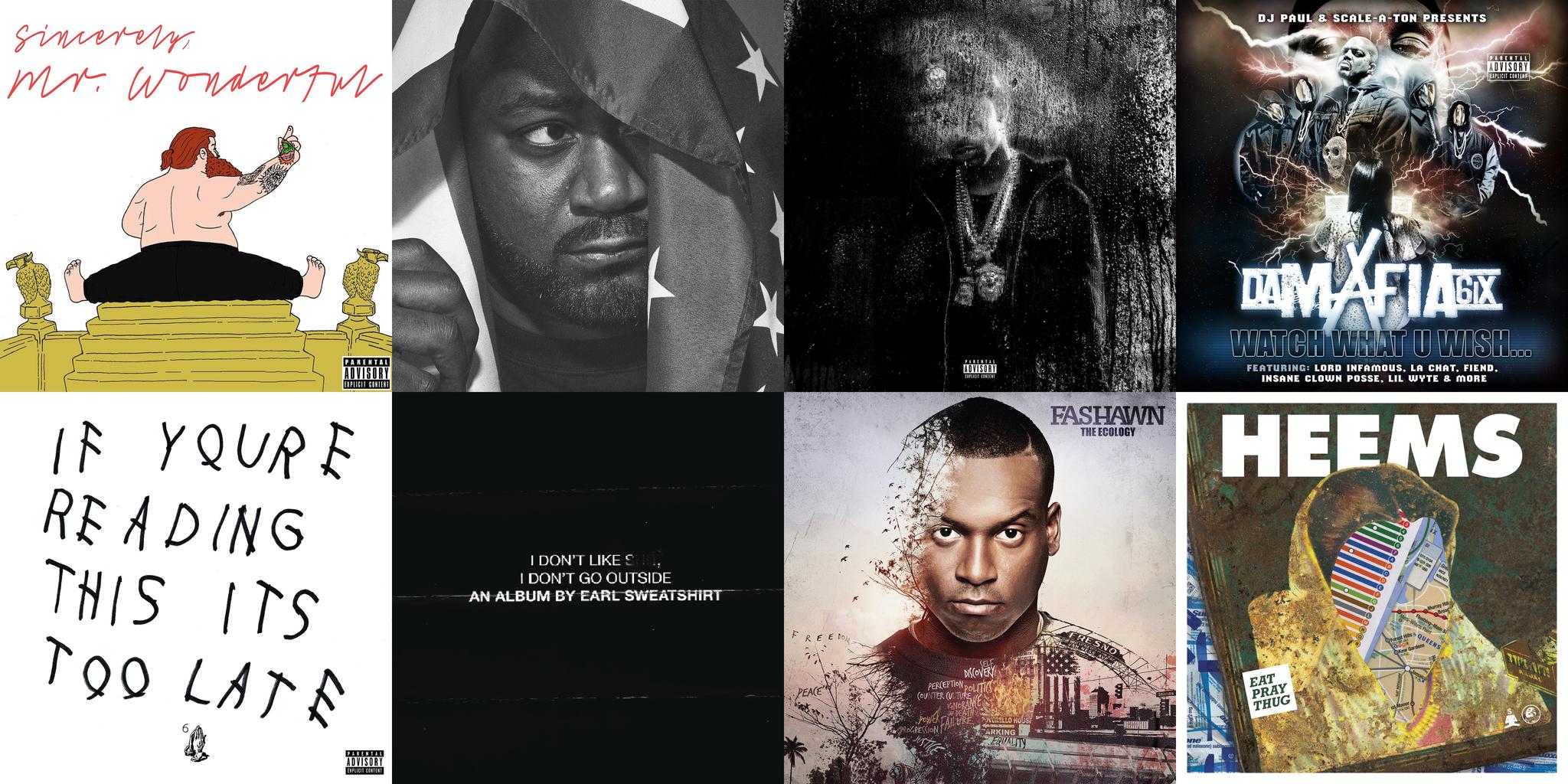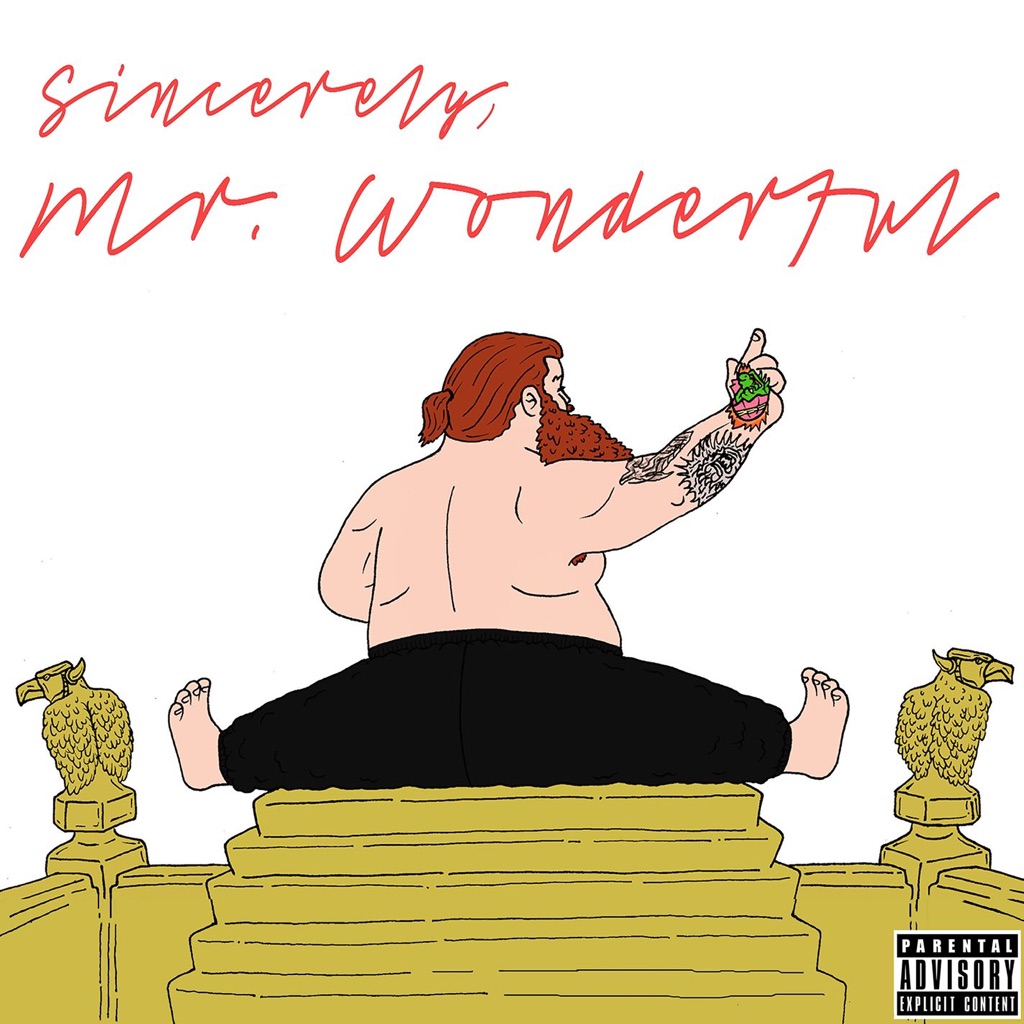
HipHopDX's Top 25 Albums of 2015 (So Far)
2015's been a hell of a year so far, and these were the 25 albums that we thought stood out above the rest.
Published: May 21, 2015 17:34
Source

Following on the heels of *Dr. Lecter* and *Saaab Stories*, Queens rapper Action Bronson releases his sprawling major-label debut. Featuring glittering, stoned-soul productions from vets like The Alchemist and newcomers like Party Supplies, *Mr. Wonderful* careens through tall tales of global travel and gourmet food with style, imagination, and a dizzying sense of humor. “All I do is eat oysters/And I speak six languages in three voices,\" Bronson raps on “Actin’ Crazy,” a testament to both talent and appetite.

Sour Soul is the collaborative album from Toronto jazz/hip-hop band BADBADNOTGOOD and Staten Island rap champ Ghostface Killah. Inspired by 1960s and 70s music - taking inspiration from the recording techniques and production of that era, and eschewing sampling in favour of live instrumentation, BBNG with producer Frank Dukes have created a dramatic, cinematic musical staging for Ghostface’s vivid storytelling. Sour Soul also features guest spots from MF DOOM, Elzhi (Slum Village / J Dilla), Danny Brown and prodigal new rapper Tree (Project mayhem).

On his third album, which sits comfortably between pomp and humility, Big Sean presents his best and most lucid plea for respect. “All Your Fault” and “Blessings” (featuring Drake and Kanye West) serve as reminders of Sean’s flashy wit and ambition, confirming his elite status among the cool kids.


Drake surprised everyone at the beginning of 2015 when he dropped *If You’re Reading This It’s Too Late*, an impressive 17-track release that combines the contemplative and confrontational with plenty of cavernous production from longtime collaborator Noah “40” Shebib. While Drizzy joins mentor Lil Wayne in questioning the loyalty of old friends on the woozy, Wondagurl-produced “Used To,” “Energy” is the cold-blooded highlight—on which he snarls, “I got enemies.” Later, amid the electrifying barbs of “6PM in New York,” Drake considers his own mortality and legacy: “28 at midnight. I wonder what’s next for me.”

Rapper Earl Sweatshirt’s third album is a dark, fascinating trip to the bottom of the self. Lyrically, Earl is a singular talent, capable of dense, expressive lines that flip back and forth between humor and pain, despair and resolve. “My days numbered, I’m focused heavy on making the most of ’em/I feel like I’m the only one pressin’ to grow upwards,” he raps on “Faucet,” over beats as hazy and fragmented as the words themselves.

Fashawn's acclaimed sophomore album, The Ecology (executive produced by Nas), features award-winning artists and producers including Nas, Aloe Blacc, Busta Rhymes, Dom Kennedy, BJ The Chicago Kid, Alchemist, Exile, DJ Khalil and more.



A powerful fusion of Cuban/African folk music, downtempo, soul and R&B, Ibeyi’s sound is like no other—groovy, haunting and organic. Of Cuban descent, the twins exploded onto the French music scene, their eponymous debut album and mesmerising hit singles “River”, “Mama Says” and “Oya” already establishing them as a lasting phenomenon of World music. Discover their potent compositions right here.

After a five-year retreat from the spotlight, Jazmine Sullivan returns with poised authority on *Reality Show*, her third full-length collection of perceptive, emotionally raw R&B. We’ve always known the Philly musician is a talented singer—her agile vocal fireworks light up tunes like \"Mascara” and “Masterpiece (Mona Lisa)”—but *Reality Show* is a huge artistic leap forward due to Sullivan’s gutsy songwriting. When she lays into tunes about everywoman trials (the disco-tinged “Stanley,” the soulful “Silver Lining,” and the sinister “#Hoodlove”), *Reality Show* is equally gritty and gratifying.

A hot young talent with an old-school soul, New York rapper Joey Bada\$$ offers a gritty, witty, and deeply lyrical alternative to current mainstream hip-hop on his long-awaited debut album *B4.DA.\$$*. Over vintage boom-bap drums and soulful samples, provided by heavyweight producers like DJ Premier and Statik Selektah, the prodigiously skilled Bada\$$ updates the rough-but-smooth vibe of golden age rap for the millennial generation, rocking a flow that’s equally inspired by the introspective rhymes of Mos Def and the intricate street tales of Nas. *B4.DA.\$$* will thrill both hip-hop veterans and rap fans too young to remember the innovative \'90s greats that Bada\$$ reveres.


Thanks to multiple hit singles—and no shortage of critical acclaim—2012’s *good kid, m.A.A.d city* propelled Kendrick Lamar into the hip-hop mainstream. His 2015 follow-up, *To Pimp a Butterfly*, served as a raised-fist rebuke to anyone who thought they had this Compton-born rapper figured out. Intertwining Afrocentric and Afrofuturist motifs with poetically personal themes and jazz-funk aesthetics, *To Pimp A Butterfly* expands beyond the gangsta rap preconceptions foisted upon Lamar’s earlier works. Even from the album’s first few seconds—which feature the sound of crackling vinyl and a faded Boris Gardiner soul sample—it’s clear *To Pimp a Butterfly* operates on an altogether different cosmic plane than its decidedly more commercial predecessor. The album’s Flying Lotus-produced opening track, “Wesley’s Theory,” includes a spoken-word invocation from musician Josef Leimberg and an appearance by Parliament-Funkadelic legend George Clinton—names that give *To Pimp a Butterfly* added atomic weight. Yet Lamar’s lustful and fantastical verses, which are as audacious as the squirmy Thundercat basslines underneath, never get lost in an album packed with huge names. Throughout *To Pimp a Butterfly*, Lamar goes beyond hip-hop success tropes: On “King Kunta,” he explores his newfound fame, alternating between anxiety and big-stepping braggadocio. On “The Blacker the Berry,” meanwhile, Lamar pointedly explores and expounds upon identity and racial dynamics, all the while reaching for a reckoning. And while “Alright” would become one of the rapper’s best-known tracks, it’s couched in harsh realities, and features an anthemic refrain delivered in a knowing, weary rasp that belies Lamar’s young age. He’s only 27, and yet he’s already seen too much. The cast assembled for this massive effort demonstrates not only Lamar’s reach, but also his vast vision. Producers Terrace Martin and Sounwave, both veterans of *good kid, m.A.A.d city*, are among the many names to work behind-the-boards here. But the album also includes turns from everyone from Snoop Dogg to SZA to Ambrose Akinmusire to Kamasi Washington—an intergenerational reunion of a musical diaspora. Their contributions—as well as the contributions of more than a dozen other players—give *To Pimp a Butterfly* a remarkable range: The contemplations of “Institutionalized” benefit greatly from guest vocalists Bilal and Anna Wise, as do the hood parables of “How Much A Dollar Cost,” which features James Fauntleroy and Ronald Isley. Meanwhile, Robert Glasper’s frenetic piano on “For Free? (Interlude)” and Pete Rock’s nimble scratches on “Complexion (A Zulu Love)” give *To Pimp a Butterfly* added energy.

Lupe Fiasco is an underground rapper with a mainstream career, and vice versa. From his label dust-ups to his shifting musical ambitions, he\'s an iconoclast who happens to be a hitmaker. He revels in this duality on *Tetsuo & Youth*. Dig the second track, \"Mural,\" which is nine minutes of dizzying raps with no guests and no hook. \"Chopper\" is similarly maximalist, featuring seven rappers and stretching nearly 10 minutes. Everything from banjo samples to \'80s metal guitars to classic boom-bap beats dot the productions. The smorgasbord of textures complements Lupe\'s seemingly endless verses, adding up to a quixotic album that\'s also one of his best.

Imbued with love, honesty, and selflessness, The Good Fight is virtuosic in its musicality, direct in its language, and infinitely relatable. In a landscape overrun with abstract indulgence and shallow trend-chasers, the Prince George’s County, Maryland artist has created a record that reminds you that it’s music before it’s hip-hop. For Oddisee, “The Good Fight” is about living fully as a musician without succumbing to the traps of hedonism, avarice, and materialism. It’s music that yields an intangible feeling: the sacral sound of an organ whine, brass horns, or a cymbal crash. It’s a meditation on our capacity to love and the bonds binding us together. It’s our ambition and greed warring with our sense of propriety - a list of paradoxes we all face when living and striving. Oddisee’s production simmers in its own orchestral gumbo. You sense he’s really a jazzman in different form, inhabiting the spirit of Roy Ayers and other past greats. The Fader’s compared him to a musical MC Escher, calling hailing his “grandiose and symphonic sound” and “relevant relatable messages.” Pitchfork praised his “eclectic soulful boom-bap.” “The Good Fight” acknowledges the stacked odds, but refuses to submit


This debut from brothers Swae Lee and Slim Jimmy, a.k.a. Rae Sremmurd, proves that Southern hip-hop is as bumping and irreverent as ever. This is the soundtrack to delinquency; its roiling low end and chopped-up beats foreground the antics of the devil-may-care protagonists. Whether it\'s praising the local gentlemen\'s club on the Minaj feature \"Throw Sum Mo\" or comparing themselves to Donald Trump, these boys just wanna have fun.

Tech N9ne built his independent rap empire by sticking to his fiercely eccentric sound and dizzyingly fast flows. So the club-friendly production and famous guests of *Special Effects* feel less like industry compromise than the product of restless ambition to try new things, like courting radio play with the crass and funny “Hood Go Crazy” or matching wits with Eminem on “Speedom (WWC2).” Even a foray into lurching dubstep on “Roadkill,” with Canadian producer Excision, is treated more like a sandbox for Tech N9ne to test out new flows.

Like *Goblin* and *Wolf* before it, the third studio album from rap’s prince of misanthropy feels like a deep dive into a sometimes-unstable mind: dreamy, dark, wildly creative, and menacingly personal. Musically, Tyler continues to explore extremes, alternating between thrash (“DEATHCAMP”), junkyard funk (“PILOT”), and low-key soul-jazz like “FIND YOUR WINGS,” making for an experience with an intensity matched by its range. Featuring Pharrell (whose productions with N.E.R.D helped draw Tyler’s musical blueprint), Kanye West, Lil Wayne, and ScHoolboy Q, among others.


*Barter 6* was billed first as Young Thug’s debut album, then a retail mixtape; either way, the 2015 release was the sharpest, clearest statement yet from Atlanta’s most enigmatic rapper. From the gently rippling intro, “Constantly Hating,” to the swirling, cathartic haze of “Just Might Be,” Thug contorts his voice into endless shapes and pulls previously unheard harmonies out of his back pocket. “Check” is a giddy celebration of success, and “Halftime” is rap as high-wire routine: a technical performance as reckless as it is graceful.